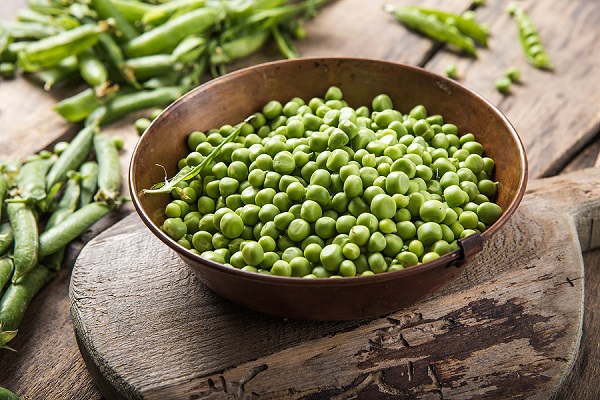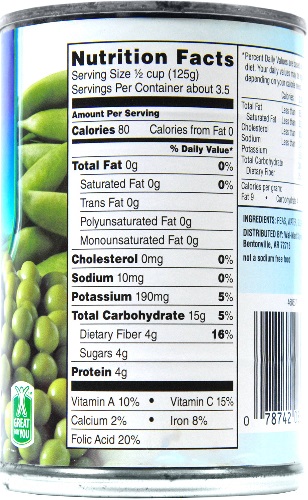- Home
- Food Questions
- Peas
Are Peas Ok on The Candida Diet?
Posted 12/14/2020 by Dan Jackowiak Nc, HHP
Pea, (Pisum sativum), also known as garden peas are an herbaceous annual plant that belongs to the legume family and are grown worldwide for its edible seeds. They are often bought fresh, frozen, or canned, and dried peas are commonly utilized in soups.
The pea is considered one of the oldest cultivated crops. The wild plant is native to the Mediterranean region, and ancient remains dating to the late Neolithic Period are found within the Middle East. European colonization introduced the crop to the New World and other regions throughout the world. Studies report that in the mid-1800s, a monastery garden run by the monk Mendel in Austria, famously employed peas in his pioneering studies of the character of heredity. (Source)
Research suggests that P. sativum was domesticated within the Middle East about 11,000 years ago. Subsequent breeding and significant improvements and enhancements has resulted in the production of thousands of pea varieties today.
Since 2003, global cultivation has ranged between 1.6 to 2.2 million planted hectares (4–5.4 million acres) producing 12–17.4 million tons per annum. (Source)

Nutrient Profile of Peas
Proteins:
Peas are the simplest plant-based sources of protein, which may be a major reason why they're so filling, alongside their high amount of fiber.
Eating protein increases the number of certain hormones in your body that reduce appetite. Protein works alongside fiber to slow digestion and promote feelings of fullness.
Eating adequate amounts of protein and fiber may automatically reduce the number of calories you eat throughout the day by keeping your appetite in control.
The unique protein content of green peas makes them a superb food choice for those that don't eat animal products. However, it's important to note that they're not a complete source of protein, since they lack the amino acid methionine.
To ensure you get enough of all the essential amino acids in your diet, it is best to eat peas with another source of protein to make up for the deficit. Consuming a sufficient amount of protein is additionally important for promoting muscle strength and bone health. (Source)
Carbohydrates:
There are 11g of carbs present with 4g coming from fiber and 4g from natural sugars in one ½ cup serving of peas. The glycemic index of the green peas is 48 while the glycemic load is 5.3 per ½ cup serving. (Source)
Fats:
Peas are very low in fat unless they are prepared with added fats.
Vitamins and Minerals:
Vitamin A: Peas contain 34% of the Recommended Daily Allowance(RDA) of vitamin A. This improves the eye-sight, reduces the risk of night blindness, and boosts the immune system.
Vitamin K: They contain 24% of the RDA of Vitamin K. This vitamin plays an essential role in blood clotting, bone metabolism, and regulates blood calcium levels.
Vitamin C: 15% of the RDA is Vitamin C which is responsible for the development, growth, and repair of all body tissues. Wound healing, absorption of collagen, and iron absorption are also some of the important functions of vitamin C.
Vitamin B1 or Thiamine: Peas contain 15% of the RDA thiamine or Vitamin B1. Vitamin B1 is useful for heart, brain, and muscle functioning. It also plays an essential role in glucose metabolism.
Vitamin B9 or Folate: Vitamin B9 makes up 12% of the RDA in peas. It is responsible for the production of red blood cells and white blood cells in the bone marrow.
Manganese: There is 11% of the RDA of manganese in peas. It helps in the improvement of bone health and it has strong antioxidant properties.
Iron: 7% of the RDA is iron. Iron helps in the regulation of body temperature and boosts immunity.
Phosphorus: Peas contain 7% of the RDA in phosphorus. It helps in the production of DNA and RNA, repairs the body tissues, and builds strong teeth.
Health Benefits of Peas
Regulates Blood-Sugar Control:
Peas have a low glycemic index, and those foods that have a low GI are useful for controlling blood sugar levels. Secondly, peas consist of protein and fiber and that is also helpful for controlling blood sugar levels. Studies suggest that foods which are rich in protein help in the stabilizing of blood sugar level in type-2 diabetes patients.
Helps in Digestion:
Peas are rich in fiber and fiber feeds the good bacteria in the intestines and that prevents the growth of unhealthy bacteria and Candida yeast in the intestines. It also reduces the risk of irritable bowel syndrome and colon cancer. Fiber also adds weight to the stool and helps in the passing through the digestive tract.
Improves Heart Health:
Peas contain important minerals and that prevent high blood pressure and possess a positive effect on heart health. The high fiber content in peas is helpful in reducing LDL cholesterol (bad cholesterol) and it also contains some antioxidants that prevent stroke and damage to cells.
Bad Health Effects of Peas
Besides the positive health effects, peas also have some downsides to their nutritional quality. Peas consist of some anti-nutrients and these anti-nutrients affect the digestion and absorption of minerals in those individuals who rely only on legumes and use peas as a staple food. Two important antinutrients are:
1. Phytic acid: this interferes with the absorption of calcium, iron, magnesium, and zinc.
2. Lectins: this interferes with nutrient absorption or may cause gas and bloating in some individuals.
However, levels of these anti-nutrients are lower in peas as compared to other legumes and likely to cause no harm unless you consume them frequently. (Source)
Are Peas Ok on The Candida Diet?
The following nutrition information is provided by the USDA for 1/2 cup (80g) of frozen peas cooked without added salt or fat.
- Calories: 62
- Fat: 0.2g
- Sodium: 58mg
- Carbohydrates: 11g
- Fiber: 3.6g
- Sugars: 3.5g
- Protein: 4.1g

Looking at a label on a can of peas for a ½ cup serving you see 15g of carbs and 4g of sugar so they are adding a little bit of sugar for taste. Quite frankly, you are better of with frozen peas because of the lower carb content and all natural plant sugars. Put them in a steamer to heat them up, add a little salt, or garlic salt, pepper and some butter to taste... delicious if you ask me.
But What About the Lectins?
A
lectin is a protein that binds to a carbohydrate. This is the very
same process that many plants use to defend themselves from pests.
These lectins resist being broken down in the gut and in susceptible
individuals, can cause nausea, vomiting, stomach upset, and diarrhea. Milder side effects can include gas and bloating.(Source)
Basically, the lectin can cause an inflammatory response in intolerant individuals leading them to believe they have an intestinal candida yeast infection. The reality for these people is they are simply intolerant or out and out allergic to lectin containing foods and should avoid them.
Peas however have a much lower lectin count than legumes such as lentils and most people are ok eating them occasionally.
Bottom Line:
For most people, green peas are ok to eat on the candida diet.
Back to Candida Diet Questions
If you have any questions about peas or any other questions about yeast infections in general, please feel free to contact us from the contact page of this website or talk to your doctor.
Home Privacy Policy Copyright Policy Disclosure Policy Doctors Store
Copyright © 2003 - 2025. All Rights Reserved under USC Title 17. Do not copy
content from the pages of this website without our expressed written consent.
To do so is Plagiarism, Not Fair Use, is Illegal, and a violation of the
The Digital Millennium Copyright Act of 1998.